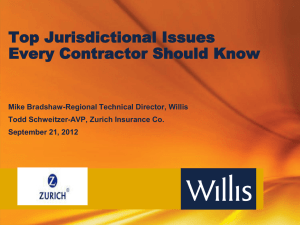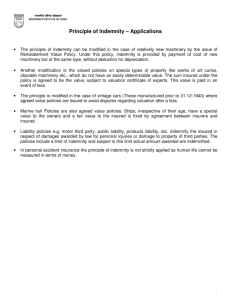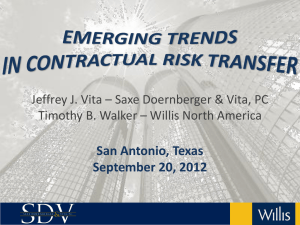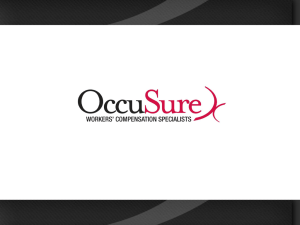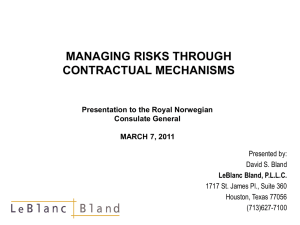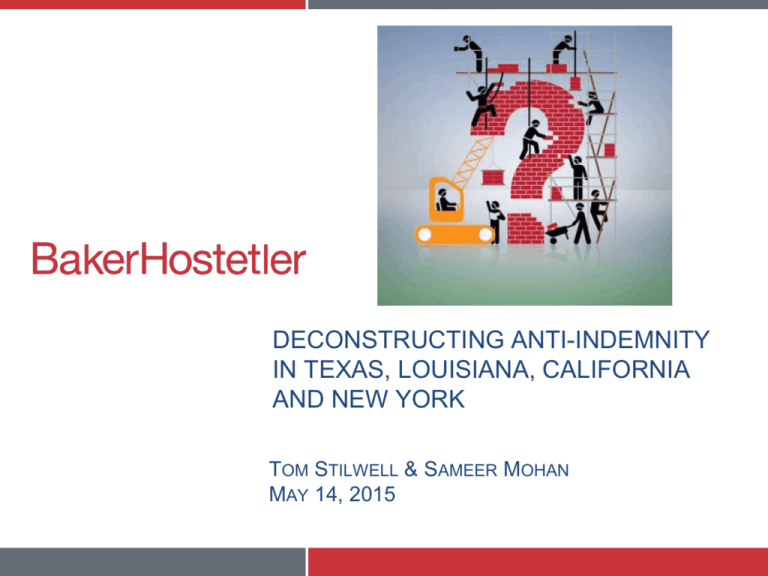
DECONSTRUCTING ANTI-INDEMNITY
IN TEXAS, LOUISIANA, CALIFORNIA
AND NEW YORK
TOM STILWELL & SAMEER MOHAN
MAY 14, 2015
Contractual Risk Transference
➢
Indemnity – a means of contractual risk transfer
▪
One party agrees to compensate another for losses
or damages that arise from the contracted action
➢
Preserves a party’s insurance limits
➢
Protects a party from assuming more liability than the benefits
received from the relationship/contract
➢
In construction projects, those higher on the chain demand
protection from those lower on the chain:
➢
▪
Owner seeks indemnity from the Architect, any Engineers (FEED), and
the General Contractor
▪
Architect, Engineer also seek indemnity from the General Contractor
▪
General Contractor seeks indemnity from the subcontractors,
suppliers, and material/equipment providers
Anti-Indemnity Statutes legislatively attempt to level the playing field
(negotiating power/positions of the parties) by invalidating broad form and
intermediate form indemnity provisions favoring the top tier of the chain
▪
Attempt to limit indemnity provisions to the fault or responsibility of the
indemnitor
2
Types of Clauses: Broad Form
➢ Broad form: Indemnitor promises to indemnify the indemnitee
regardless of fault
▪
Including for the indemnitee's sole negligence
▪
I.e. Subcontractor agrees to indemnify the General Contractor
for the General Contractor's sole fault and negligence
➢ Example:
▪
The Subcontractor shall indemnify and hold harmless the
Owner and Contractor and all their agents and employees from
and against all claims, damages, losses and expenses,
including attorney’s fees, arising out of or resulting from the
performance of the Subcontractor’s work regardless of fault,
whether it is caused in whole or in part by the negligence of
Owner or Contractor. It is specifically understood that this
indemnity shall be interpreted as indemnifying Owner,
Contractor and their agents and representatives from their own
sole and/or partial negligence.
3
Types of Clauses: Intermediate Form
➢ Intermediate Form: Indemnitor assumes responsibility for its own sole
negligence or partial negligence. If the indemnitee is solely at fault, there is no
indemnity.
➢
➢
▪
Shifts the risk where both parties have, in some percentage, contributed to the
loss
▪
I.e. Both parties are jointly or contributorily at fault / responsible for the loss
Two Types:
▪
Full Indemnity: If the subcontractor is partially at fault, it pays all damages. An
owner or general contractor who is 99% at fault still receives indemnity.
▪
Partial Indemnity: Indemnity is calculated on a sliding scale up to the
indemnitor’s percentage of responsibility for the loss. If the owner/contractor is
60% at fault, they can receive 40% indemnity from the subcontractor.
Example: To the fullest extent permitted by law, the Subcontractor shall indemnify,
defend, and hold harmless the Owner, Contractor, … their agents, consultants, and
employees ... from and against claims, damages, losses and expenses, including but
not limited to attorneys' fees, arising out of or resulting from performance of the
Subcontractor's work, …, but only to the extent caused in whole or in part by the
negligent acts or omissions of the Subcontractor, regardless of whether or not such a
claim, damage, loss or expense is caused in part by a party indemnified hereunder.
This clause is not intended to indemnify and indemnified party for claims, damages,
losses and expenses caused by the sole negligence of the indemnitee.
4
Types of Clauses: Limited Form
➢ Limited Form: Indemnitor assumes responsibility for its
own sole negligence. There is no protection for an
indemnitee who is partially or contributorily at fault.
▪
Most favorable clause for subcontractors
▪
Subcontractor only agrees to indemnify the General
Contractor for the Subcontractor's own sole fault /
negligence
➢ Example: The Subcontractor shall indemnify, defend and
hold harmless the Owner, Contractor, …, their agents,
consultants and employees from and against all claims,
losses, costs and damages, including but not limited to
attorney’s fees, pertaining to the performance of the
Subcontractor’s work, …, but only to the extent solely caused
by the negligent acts or omissions of the Subcontractor, the
Subcontractor's subcontractors, or anyone directly or
indirectly employed by them.
5
Additional Insured Provisions
➢ Indemnity agreements provide assurance of responsibility,
not insurance for the loss
➢ Additional insured provision requires the indemnifying party to
obtain insurance to support the indemnity obligation
▪
and to obtain an endorsement naming the indemnitee
(owner/general contractor/architect) as an additional
insured on the policy
➢ Separate and distinct obligation from the
indemnity provision
➢ Parties may limit the scope of the insurance
coverage to the indemnitor's indemnity
obligation
▪
Prevents unlimited coverage for the
indemnitee beyond the scope of the
contractual indemnification
6
States with Anti-Indemnity Statutes
➢ 43 states possess some form of antiindemnity statute
➢ 18 states prohibit "broad form" indemnity
provisions
➢ 25 states prohibit "intermediate form"
indemnity provisions
➢ Every state allows "limited form" indemnity
provisions
➢ 11 states limit additional insured
provisions
March 26, 2015
7
4 State Comparison
State
Statute
Prohibits
Indemnity for
sole
negligence of
the
indemnitee?
Prohibits
indemnity for
the partial
negligence /
fault of the
indemnitee
Prohibits
Additional
Insured
Clauses
protecting the
indemnitee
Prohibits
Choice of Law
Clauses
nominating
other
jurisdictional
law
Notable
Provision
Texas
Texas Ins. Code
§ 151.102
X
X
X
X
Employee
personal injury
and wrongful
death exclusion
Louisiana
La-R.S. §
9:2780
X
X
X
X
Saves voidable
indemnity
clauses if the
indemnitee pays
for insurance to
support the
obligation
California
Cal. Civ. Code
§ 2782
(General)
X
X
X
Encourages
additional
insured
provisions
X
X
§ 2782.05
(Contractor/Sub
contractor)
New York
NY. Gen. Oblig.
Law
§ 5-322.1
Encourages
additional
insured
provisions
8
9
Texas: Common Law
➢
Texas courts generally enforce indemnity provisions if
▪
Unambiguous, and
▪
does not violate the constitution, statute, or public policy
−
➢
Texas follows general contract drafting principals when interpreting indemnity language
▪
If the provision is not ambiguous, the court will give effect to the stated intentions of
the parties
▪
If the provision is ambiguous, the court will construe the provision in favor of the
indemnitor
▪
➢
Prospective indemnity for gross negligence or intentional torts probably violates
public policy
−
strictly interpreted against the indemnitee,
−
meaning the indemnity provision will likely be invalidated
−
prevents indemnification to extend by implication or assumption beyond the
precise terms of the agreement
Words and phrases are given their ordinary, popular, commonly-accepted meaning
Texas still follows Fair Notice Requirements
▪
Anti-indemnity statute is silent as to the common law fair notice requirements
▪
Practice Tip: Continue to draft indemnity clauses to meet the fair notice requirements
10
Texas Fair Notice Requirements
➢
Express Negligence Rule - parties must state their intention to transfer risk, and the amount
and type of risk, plainly within the 4 corners of the contract
▪
To indemnify for the indemnitee’s fault/negligence, Courts look for "magic language"
−
Even “to the extent the claim, loss, or damage is caused by the sole, joint,
concurrent, comparative, or contributory negligence or fault of the indemnitee”
−
Indemnification for the indemnitee's "own negligence”
−
“Regardless of fault”
➢
Conspicuous - the presence of the indemnity clause must attract attention of the reader
▪
Conspicuous
−
UCC definition - a term or clause is conspicuous when it is so written that a
reasonable person against whom it is to operate ought to have noticed it
•
capital headings, larger font size, contrasting font color, bold type
−
More visible than other items on the page
▪
Not Conspicuous
−
Hidden on the reverse side of the document under the heading "warranty"
−
printed in small, light, text on the back of a delivery ticket
−
surrounded by unrelated terms
▪
Sometimes viewed on a sliding scale of acceptability based upon the length and
complexity of the contract at issue
➢
Actual notice or actual knowledge serves as an exception to fair notice requirements
11
Texas Anti-Indemnity Statute
➢ Texas Insurance Code § 151.102
➢ “…a provision in a construction contract, or in an
agreement collateral to or affecting a construction
contract, is void and unenforceable as against
public policy to the extent that it requires an
indemnitor to indemnify, hold harmless, or defend
a party, including a third party, against a claim
caused by the negligence or fault, the breach or
violation of a statute, ordinance, governmental
regulation, standard, or rule, or the breach of
contract of the indemnitee, its agent or employee,
or any third-party under the control or supervision
of the indemnitee, other than the indemnitor or its
agent, employee, or subcontractor of any tier.”
12
Texas Anti-Indemnity Explained
➢ Effective as to indemnity provisions in construction
contracts after January 1, 2012
➢ Prohibits any indemnification of the indemnitee for
the indemnitee’s own negligence
▪ General contractor cannot demand indemnity
from a sub for the GC’s own negligence or
fault
▪ Cannot obtain indemnity for GC’s partial,
concurrent, or comparative fault
▪ Indemnification for percentage of fault
attributable to the indemnitor (sub) is allowed
➢ Eliminates use of broad form and intermediate
form indemnity provisions
13
Employee Injury Exception
➢ Texas Insurance Code § 151.103: “Section 151.102 does not apply
to a provision in a construction contract that requires a person to
indemnify, hold harmless, or defend another party to the
construction contract or a third party against a claim for the bodily
injury or death of an employee of the indemnitor, its agent, or its
subcontractor of any tier.”
➢ Allows broad form indemnity for employee injury / death claims
▪
Sub can still indemnify the GC for the GC’s sole or concurrent
fault if the claim is made by an employee of the sub, or any
sub-subcontractor of any tier
▪
Even if the GC is wholly or partially at fault, negligent, or
otherwise responsible for the loss
➢ Practice Tip: Draft bifurcated indemnity provisions in indemnity
contracts
▪
One clause dealing with property losses and non-employee
damage claims
▪
One clause dealing with employee personal injury/death claims
14
Texas Exclusions § 151.105
➢
Insurance Agreements (other than additional insured provisions) including OCIP and CCIP
programs
➢
Breach of contract or warranty actions
▪
Requires the breach of contract or warranty action to be completely separate from the
indemnity obligation
▪
Cannot use the act to shield yourself or avoid a direct breach of contract action
➢
Loan and financing documents (other than construction contracts to which lenders are a party)
➢
General agreements of indemnity required by bond sureties
➢
Workers compensation agreements, benefits and protections
➢
Governmental immunity protections
➢
Agreements governed by the Texas Oilfield Anti-Indemnity Act
➢
License or access agreements with railroad companies
➢
Indemnity provisions related to copyright infringement claims
➢
Construction contracts pertaining to single family homes, townhomes, and duplexes
➢
Public works projects of municipalities
▪
➢
Preserves exclusions for governmental immunity protections
Joint defense agreements entered after a claim is made
15
Texas Construction Contract Defined
Luminant Oak Grove, Solid Fueled Power Generating Station
16
Texas “Construction Contract” Defined
➢
Anti-Indemnity Statute applies to construction contracts and agreements “collateral to or affecting” a
construction contract
➢
Texas Construction Contract Definition Insurance Code § 151.001(5)
▪
Includes any agreement for the design, construction, alteration, renovation, remodeling, repair or
maintenance of,
▪
Or furnishing material or equipment for
▪
A building, structure, appurtenance, or other improvement
▪
On public or private property
▪
Including moving, demolition, and excavation connected with the real property
➢
People covered in the definition: owners, architects, engineers, contractors, construction managers,
subcontractors, suppliers, and material or equipment lessors.
➢
Broadly includes activities not thought of as pure construction
▪
➢
➢
Remodeling, maintenance, moving
No definition or guidance as to a “collateral” agreement
▪
TOAIA - uses similar language - collateral to or affecting an agreement related to an oil or gas
well or mine.
▪
This language has been interpreted to require some connection between the contract and the
actual services performed on a well or mine.
Similarly, construction statute may require some connection to real property (land) and actual services
performed on the land
17
Texas Additional Insured Provisions
➢ Tex. Ins. Code § 151.104 – voids any
requirement for the indemnitor to obtain
additional insured coverage or to provide the
indemnitee with an additional insured
endorsement, to the extent it requires
coverage beyond scope of indemnity allowed
under the statute
➢ Cannot use a separate additional insured
clause to circumvent the statute
➢ Cannot require insurance for indemnitor’s
own negligence or fault
➢ OCIP and CCIP (Wrap-Up Insurance)
programs are allowed
18
Texas: Choice of Law Not Allowed
➢ Tex. Ins. Code § 151.151 – No waiver of
the statute
➢ “A provision of this chapter may not be
waived by contract or otherwise.”
➢ Effectively prevents the parties from
choosing another state’s law to apply to
the construction project
19
Texas: Architects & Licensed Engineers
➢
Texas Civil Practice & Remedies Code § 130.002
➢
Voids provisions in a construction contract requiring a contractor to indemnify a registered
architect or licensed engineer for damage that:
➢
▪
Results from defects in plans, designs, or specifications prepared, approved, or used
by the architect or engineer; or
▪
Negligence of the architect or engineer in the performance of his/her professional
duties, AND
▪
Arises from
Personal injury or death
−
Property injury
−
Or any other expense that arises from personal injury, death, or property
injury.
Also voids provisions requiring a registered architect or licensed engineer to indemnify or
hold harmless an owner from the owner’s negligence or fault
▪
➢
−
But Limitation of liability clauses between an owner and registered architect or
licensed engineer are specifically approved
Definition of a construction contract in this section includes roads, highways, bridges,
dams, and levees specifically
20
Texas: Architects & Engineers - Exceptions
➢ Does not apply to certain residential construction:
owners of single family or multifamily residences
▪
Apartment complexes probably do not fall in
this exception
➢ Does not apply to owners of interests in real
property
➢ Does not apply to provisions indemnifying an
architect or licensed engineer for other negligent
acts
➢ Does not apply to provisions indemnifying an
architect or licensed engineer from the negligent
acts of a contractor or subcontractor
21
Texas Practice Tips
➢
➢
Consider a bifurcated indemnity clause
▪
One clause addresses employee injury/death claims – broad form / sole negligence allowed
▪
One clause considers property claims – limited form up to indemnitor’s negligence
▪
Design professionals need a third clause indemnifying for losses such as delays/cost overruns –
something other than defects in plans or professional negligence causing injury or property loss
In the indemnity clauses, state that they will be applicable “to the extent allowed by law”
▪
This language may allow the court to find the parties intent to comply with the limits or provisions
of the statute
➢
Make sure the clause still meets the Fair Notice requirements – express negligence rule and
conspicuous
➢
Consider a multi-tier additional insured provision
▪
Additional insured provision “to the extent” of or limit of the indemnity provision
▪
Consider a separate provision relating to employee injury claims that includes coverage for the
negligence of the indemnitee in employee claims
➢
Include a severability clause or savings clause that protects the indemnity, additional insured, and other
limitation of liability clauses in the event that any one provision is found to be invalid
➢
Include limitation of liability clauses and waivers of consequential, indirect damages
➢
Texas law may not be avoided, but include a forum selection clause nominating a particular court or
county in which the dispute must be pursued and resolved
22
23
Louisiana: Common Law
➢ Indemnity agreements are generally enforceable
➢ General contractual interpretation rules apply
➢ When the common intent of the parties and the words of the
contract are clear and lead to no absurd consequences, no further
interpretation may be made in search of the parties intent.
➢ The obligation to indemnify must arise from an unequivocal express
agreement in the contract
▪
The controlling question is whether the risk that resulted in the
injury was one contemplated by the parties to the contract.
➢ Indemnification for the indemnitee's own negligence must be
expressed in unequivocal terms
▪
If there is doubt, there is a presumption the parties did not
intend to indemnify the indemnitee against losses caused by
the indemnitee's own negligence
➢ “Any and all liability" does not, alone, establish an intent to
indemnify the indemnitee for the indemnitee's sole negligence
24
Louisiana: Anti-Indemnity Statute
➢ LSA-R.S. 9:2780.1B.
➢ “…any provision, clause, covenant, or agreement
contained in, collateral to, or affecting a motor
carrier transportation agreement or construction
contract which purports to indemnify, defend, or
hold harmless, or has the effect of indemnifying,
defending, or holding harmless, the indemnitee
from and against any liability for loss or damage
resulting from the negligence or intentional acts or
omissions of the indemnitee, an agent or
employee of the indemnitee, or a third party over
which the indemnitor has no control is contrary to
the public policy of this state and is null, void, and
unenforceable.”
25
Louisiana: Anti-Indemnity Explained
➢ La. Rev. Stat. Ann. sec. 9:2780.1 (applicable to contracts
entered after January 1, 2011)
➢ Does not permit indemnification for the negligence or
intentional acts or omissions of the indemnitee
▪
Prohibits Broad form and Intermediate form indemnity
provisions
▪
Sub cannot be required to indemnify GC for GC’s
negligence (full or partial) or intentional conduct
➢ Does not permit indemnification for the negligence or
intentional acts of a third party over whom the indemnitor has
no control
➢ Allows indemnity for negligence of the promisor
▪
Contributory fault / negligence of the promisor may be
indemnified
26
Louisiana Construction Contract: Defined
Mercedes Benz Superdome
27
Louisiana Construction Contract: Defined
➢ Construction contract definition includes agreements:
▪
For the design, construction, alteration, renovation, repair
or maintenance
▪
Of buildings, structures, highways, roads, bridges, water
lines, sewer lines, oil lines, gas lines,
▪
Appurtenances or improvements to real property
▪
Including moving, demolition and excavation
➢ Does not include dirt or gravel roads used to access oil and
gas wells and associated facilities
➢ Does not include oil flow lines and gas gathering lines from
the point where product is co-mingled for transportation.
➢ Includes “design” in the definition of construction
▪
One of the few references to design professionals in the
statute
28
Louisiana: Insurance Exception
➢ Similar to the LaOAIA - an insurance exception exists
➢ Indemnification provision is not invalid, if the contract also requires
the indemnitor to obtain insurance to insure the obligation to
indemnify, defend, or hold harmless, and there is evidence that the
indemnitor recovered the cost of the required insurance in the
contract price.
▪
Indemnity limited to the amount of insurance proceeds
available under the insurance policy the indemnitor was
required to obtain by contract
➢ Provision saves an otherwise invalid indemnity clause
➢ Under this exception, may also name the other party as an
additional insured to the required insurance
▪
Such insurance is valid only if it applies when the indemnitor is
at least partially at fault
➢ Otherwise, statute invalidates additional insured provisions that
covers the acts or omissions of the indemnitee
29
Louisiana: Public Works Contracts
➢ La. R. S. 38:2195 (public contracts) - public entities are prohibited
from assuming liability for damages caused by others with whom the
public entity contracts
▪
Voids indemnity agreements by the state or governmental
entities
➢ La. Rev. Stat. Sec. 38:2216.G (public contracts)
▪
Voids indemnity agreement requiring a contractor to protect the
governmental entity from third party claims caused by the
governmental entity
▪
Voids indemnity agreement protecting architects, landscape
architects, engineers, or land surveyors hired /contracted by a
governmental entity for damages caused by their negligence
➢ Applies to prime contractors only
➢ Bars indemnity for the indemnitee's negligence, sole or partial
➢ Allows indemnity for concurrent negligence, up to the percentage
attributable to the indemnitor
30
Louisiana: Choice of Law
➢ La R.S. 9:2779 holds choice of forum and choice of law
provisions invalid
▪
When one party is domiciled in Louisiana, and
▪
The work, materials, and equipment involve a
construction project in Louisiana
➢ Requires the lawsuit or arbitration to occur in Louisiana
➢ Voids provision requiring interpretation of the agreement
under another jurisdiction's law
➢ La R.S. 9:2778 same provisions with respect to public
contracts involving the state or a political subdivision of the
state
➢ Effectively prevents ability of a party to contract around
application of Louisiana Construction Anti-Indemnity Statute
31
Louisiana: Practice Tips
➢
Expressly state the intention to indemnify and the scope of the indemnity
➢
Single global indemnity clause acceptable – no differentiation for personal injury,
property loss, or design negligence
➢
To indemnify another party for their own negligence, specifically support the
provision with an insurance provision
▪
State that part of the contract consideration includes the indemnitor’s
recovery of the cost of the insurance for the indemnitee
▪
Utilize a separate additional insured provision stating that it applies to the
indemnitee’s own negligence
➢
Use severability clauses to protect the remainder of the contract from any invalid
provision
➢
Include limitation of liability clauses – waivers of consequential and indirect
damages
➢
Cannot avoid La law or jurisdiction, but consider a venue provision requiring
disputes to be brought in a particular court or parish of Louisiana
▪
Avoids disputes in liberal parishes
▪
Nominate a federal court in Louisiana
32
33
California: Common Law
➢ Agreements interpreted to give effect to the
mutual intent of the parties as it existed at the
time of contracting
➢ Strictly construed against the indemnitee
➢ May indemnify the indemnitee for the
indemnitee's own active negligence
▪ Must use sufficiently specific language
▪ Must be clear and explicit
➢ In the absence of express language, the
provision will be interpreted to indemnify the
indemnitee only for the indemnitee's passive
negligence
34
California Distinguishes Between
Active & Passive Negligence
➢ Passive negligence ▪
mere nonfeasance
▪
failure to discover a defect
▪
failure to perform a duty
➢ Active negligence - exists where there is participation in some
manner in the conduct or omission which cause the injury beyond
mere failure to perform a duty imposed on him by law.
▪
personal participation of the indemnitee in affirmative acts
▪
failure to perform a precise duty agreed to be performed
➢ Indemnity for active negligence requires a plain, clear, and explicit
statement in the clause that negligence is to be included in the
indemnity and such language will be strictly construed against the
indemnitee
➢ Definitions assessed on a case by case basis with each case
turning on its own facts
35
California’s Anti-Indemnity Statute
(General Provision)
➢ § 2782 “…provisions, clauses, covenants, or
agreements contained in, collateral to, or affecting any
construction contract and that purport to indemnify the
promisee against liability for damages for death or
bodily injury to persons, injury to property, or any other
loss, damage or expense arising from the sole
negligence or willful misconduct of the promisee or the
promisee’s agents, servants or independent
contractors who are directly responsible to the
promisee, or for defects in design furnished by those
persons, are against public policy and are void and
unenforceable; provided, however, that this section
shall not affect the validity of any insurance contract,
workers’ compensation, or agreement issued by an
admitted insurer as defined by the Insurance Code.”
36
California: Anti-Indemnity Explained
➢
➢
➢
§ 2782(a) – General Clause Prohibits indemnity for sole negligence or willful misconduct of the indemnitee,
▪
Allows Intermediate form indemnity: allows full indemnification of the indemnitee, so long as the
indemnitor is at least 1% responsible for the loss
▪
Also voids agreements where a party seeks indemnification for defects in design furnished by the
indemnitee or its agents
§ 2782(B)(2) Public Agencies – Agreements relieving a public agency of liability for the agency’s active
negligence are void and unenforceable
▪
Protects contractors, subcontractors, and suppliers of goods
▪
Allows Intermediate form indemnity – may indemnify to the extent of indemnitor’s negligence
▪
In the event of passive negligence, broad form indemnity for sole negligence of the indemnitee is
allowed
§2782(C)(1) Private Owners of Real Estate– Agreements relieving a private owner from liability are
unenforceable to the extent of the active negligence of the owner
▪
Protects contractors, subcontractors and suppliers of goods
▪
Allows Intermediate form indemnity – may indemnify for indemnitor’s negligence
▪
In the event of passive negligence, broad form indemnity is allowed
▪
Private owner exceptions:
−
when the private owner is acting as a contractor or supplier of materials or equipment to the
work (2782(c)(1)or is a homeowner performing an improvement on his or her single family
dwelling (2782(c)(3)).
37
California’s Anti-Indemnity Statute
(Contractor/Subcontractor)
➢ § 2782.05 “…provisions, clauses, covenants, and agreements
contained in, collateral to, or affecting any construction contract and
amendments thereto entered into on or after January 1, 2013, that
purport to insure or indemnify, including the cost to defend, a
general contractor, construction manager, or other subcontractor, by
a subcontractor against liability for claims of death or bodily injury to
persons, injury to property, or any other loss, damage, or expense
are void and unenforceable to the extent the claims arise out of,
pertain to, or relate to the active negligence or willful misconduct of
that general contractor, construction manager, or other
subcontractor, or their other agents, other servants or other
independent contractors who are responsible to the general
contractor, construction manager, or other subcontractor, or for
defects in design furnished by those persons, or to the extent the
claims do not arise out of the scope of work of the subcontractor
pursuant to the construction contract. This section shall not be
waived or modified by contractual agreement, act, or omission of the
parties. Contractual provisions, clauses, covenants, or agreements
not expressly prohibited herein are reserved to the agreement of the
parties….”
38
California: Anti-Indemnity Explained
➢
§ 2782.05 - Agreements between General Contractors, Construction Managers, or
Subcontractors
➢
Agreements indemnifying or insuring a general contractors, construction manager, or other
subcontractor, by a subcontractor are void and unenforceable to the extent the claims arise
out of or relate to
➢
▪
the active negligence or willful misconduct of the general contractor, construction
manager, or subcontractor, or
▪
Defects in design furnished by the general contractor, construction manager, or
subcontractor or
▪
Claims that do not arise out of the subcontractor’s scope of work
For active negligence
▪
Bars broad form indemnity provisions
▪
Permits Limited form indemnity provisions, up to negligence of indemnitor
➢
For passive negligence – allows full indemnity under a broad form provision
➢
No Alternate Choice of Law: the statute prohibits its waiver by contractual agreement, act
or omission of the parties
➢
Limitations of liability are permitted and reserved to the agreement of the parties
39
California: Exceptions
➢
§ 2782.05 (a) protecting subcontractors does not apply to:
1.
Contracts for residential construction
2.
Direct contracts with a public agency
3.
Direct contracts with owners of privately owned real estate
4.
Wrap-up insurance programs (OCIP / CCIP)
5.
Breach of warranty claims existing independently of the indemnity
obligation
6.
Additional insured provisions
7.
Loan and financing documents
8.
Indemnities required by sureties
9.
Workers compensation agreements / benefits
10. Governmental immunity laws / benefits
11. Provisions requiring the purchase of insurance
12. Contracts with design professionals
40
California: Construction Contract Defined
Centinela Solar Power Plant
41
California: Construction Contract Defined
➢
Very broad definition
➢
Activities Included: construction, surveying, design, specifications, alteration, repair,
renovation, maintenance, removal of or demolition of
➢
Projects: buildings, highways, roads, parking facilities, bridges, water lines, sewer lines, oil
line, gas line, electric utility transmission or distribution line, railroad, airport, pier or dock,
excavation
➢
Or other structure, appurtenance, development or other improvement to real or personal
property,
➢
Collateral Activities Included: Agreements to perform any portion thereof or any act
collateral thereto, or to perform any service reasonably related thereto, including,
➢
▪
the erection of all structures or performance of work in connection therewith,
▪
electrical power line clearing, tree trimming, vegetation maintenance,
▪
the rental of all equipment,
▪
all incidental transportation, moving, lifting, crane and rigging service
▪
and other goods and services furnished in connection therewith.
Covers incidental activities that may support construction, but are not typically or
traditionally considered construction
42
California: No Waiver
➢ California prohibits choice of law clauses to
avoid the effect of the statute
➢ Cannot circumvent the statute by nominating
another state’s law in the contract
➢ § 2782.05(c): “Notwithstanding any choice of
law rules that would apply the laws of another
jurisdiction, the law of California shall apply to
every contract to which this section applies.”
➢ § 2782.05(d): “A waiver of the provisions of
this section is contrary to public policy and is
void and unenforceable.”
43
California: Encourages Additional
Insured Provisions
➢ California’s anti-indemnity statute
does not invalidate additional insured
provisions
➢ §2782.05(n) “Nothing in this section
shall be construed to affect the
obligation, if any, of either a
contractor or construction manager
to provide or maintain insurance
covering the acts or omissions of the
promisor, including additional
insurance endorsements covering
the acts or omissions of the promisor
during ongoing and completed
operations pursuant to a construction
contract with a public agency …or an
owner of privately owned real
property to be improved….”
44
California: Design Professionals
➢ Contracts between Design Professionals and Public Agencies
▪
Agreements requiring a design professional to indemnify
a public agency are unenforceable except for claims that
arise out of the negligence, recklessness, or willful
misconduct of the design professional
−
Does not distinguish between active and passive
negligence
−
Allows a Limited form indemnity clause, indemnifying
the public agency for the design professional’s
responsibility for the loss/claim
➢ Design professionals include licensed architects, licensed
landscape architects, registered professional engineers, and
licensed professional land surveyors.
➢ This provision may not be waived or modified by contract, act,
or omission of the parties
45
California: Drafting Suggestions
➢
➢
Separate indemnity clauses to account for active and passive negligence of the parties
▪
Active negligence - each party only indemnifies for its own fault
▪
Passive negligence – indemnity flowing to owners (public or private) or contractor (upper
tier contractor), full indemnity regardless of fault allowed
For GC/Sub relationships, limit indemnity to sub’s scope of work
▪
Draft broad scope of work clauses for all subs
−
➢
Consider a catchall indemnity meeting 2782 general provision
▪
➢
Where no other specific indemnity provision applies, indemnitor will fully indemnify
indemnitee if the indemnitor is alleged to be solely or partially at fault/negligent, whether
active or passive.
Include broad additional insured provisions
▪
➢
Remember ancillary activities such as trucking to site/deliveries on site
Only way to protect against design defect claims – indemnity prohibited
Include limitations of liability clauses
▪
§2782.5 permits “allocation, release, liquidation, exclusion, or limitation” for
−
Design defects
−
Promisor’s liability under a construction contract
46
47
New York: Common Law
➢
Contractual agreements to indemnify are enforceable in New York
▪
Strictly construed
➢
Will not be enforced unless there is manifestation of "clear and
unmistakable intent to indemnify.”
➢
If the intent is unclear from the writing, the court is required to consider
extrinsic evidence of intent
▪
➢
If there is "unmistakable intent" to indemnify an indemnitee for its own
negligence, the Court will enforce it.
▪
➢
the intent must be "unattended by danger of misconception in the
purport of the contract itself, and concerning which there is not
reasonable basis for a difference of opinion.”
An agreement to indemnify "whether ... damages or injuries be
attributable to negligence of the contractor or his employees or
otherwise" extends indemnity for the indemnitee's own negligence.
Where the indemnitee is actively negligent, greater scrutiny is applied to the
indemnification clause.
48
New York: Anti-Indemnity Statute
➢ New York General Obligations Law § 5-322.1
➢ “A covenant, promise, agreement or understanding in, or in
connection with or collateral to a contract or agreement relative to
the construction, alteration, repair or maintenance of a building,
structure, appurtenances and appliances including moving,
demolition and excavating connected therewith, purporting to
indemnify or hold harmless the promisee against liability for damage
arising out of bodily injury to persons or damage to property
contributed to, caused by, or resulting from the negligence of the
promisee, his agents or employees, or indemnitee, whether such
negligence be in whole or in part, is against public policy and is void
and unenforceable; provided that this section shall not affect the
validity of any insurance contract, workers’ compensation
agreement or other agreement issued by an admitted insurer. This
subdivision shall not preclude a promisee from requiring
indemnification for damages arising out of bodily injury to persons or
damage to property caused by or resulting from the negligence of a
party other than the promisee, whether or not the promisor is
partially negligent.”
49
New York: Anti-Indemnity Explained
➢ NY Gen. Oblig. Law sec. 5-322.1
➢ Applies to all contracts to provide construction services after July
16, 2009.
➢ Applies promises and agreements in connection with or collateral to
a contract for the construction, alteration, repair, or maintenance of
a building, structure, appurtenances and appliances including
moving, demolition, and excavating connected therewith
➢ Prohibits indemnification of a party for their own actual negligence
▪
In whole or in part
−
▪
Bars indemnification for indemnitee's sole or
concurrent/partial negligence
Allows indemnification up to the fault attributable to the
indemnitor
➢ Effectively prohibits Broad Form and Intermediate Form indemnity
provisions
50
New York: Exceptions
➢ Anti-Indemnity statute does not prohibit or void a requirement
to purchase insurance indemnifying another person for their
own negligence
▪
Additional insured provisions are allowed
−
▪
No limitation on the scope of an additional insured
provision
New York encourages the use of insurance to allocate
risk
➢ Statute does not prevent a GC from requiring a sub to
indemnify the GC for the acts of an owner, architect,
engineer, (upper tier entity) or a material supplier, equipment
provider, or sub-subcontractor (lower tier entity)
▪
Prohibition on indemnity solely prevents an entity from
receiving protection for his/her own negligence (fault)
51
New York: Design Professionals
52
New York: Design Professionals
➢
NY Gen. Oblig. Law sec. 5-324
➢
Includes architects, engineers, and surveyors
➢
Applies to such professional seeking indemnity for liability arising out of
defective maps, plans, designs or specifications prepared, acquired, or
used by the architect, engineer, or surveyor
➢
▪
Does not have to be an original document created by the professional
▪
Applies to documents “acquired” OR “used”
▪
Could be furnished by another party in the chain
Bars indemnity of the architect, engineer, or surveyor for liability that arises
out of defects in the maps, plans, designs or specifications
▪
Architect, Engineer, Surveyor are strictly liable for all defects
▪
Prohibits indemnity for professional’s sole negligence
▪
Prohibits indemnity for professional’s concurrent/partial negligence
▪
Prohibits indemnity for an innocent professional if the loss is alleged to
be attributable to the defects in the maps, plans, designs, or
specifications
53
New York: Drafting Considerations
➢
➢
NY does not prohibit choice of law clauses. Consider the law being chosen to govern the contract
▪
Include a clear choice of law provisions nominating favorable law
▪
Include a clear forum selection provision nominating a venue in which a dispute must be
pursued/resolved
Broad indemnity agreement covering all types of loss is permissible
▪
Limit indemnity to each party’s own negligence, but specify the duty to indemnify occurs
even when the indemnitee is partially negligent/at fault
▪
“To the fullest extent of law” will save an indemnity clause
−
➢
Consider separating indemnity for contractors vs. architects, engineers, and surveyors and treat
design defect claims separately
▪
➢
Courts will interpret the parties’ intent as to comply with the statute
Cannot indemnify for design defect claims / protect risk through additional insured clause
Require as broad an additional insured clause as possible
▪
If applicable, specifically include protection for architects, engineers, and surveyors for
design defect claims
➢
Include a severability / savings clause to prevent any one provision from invalidating all
provisions
➢
Include waivers of consequential and indirect damages
54
Tom Stilwell
Telephone: 713-646-1378
Mobile No: 832-274-6749
tstilwell@bakerlaw.com
Atlanta
Chicago
Cincinnati
Cleveland
Columbus
Costa Mesa
Denver
Houston
Los Angeles
New York
Orlando
Philadelphia
Seattle
Washington, DC
www.bakerlaw.com
These materials have been prepared by Baker & Hostetler LLP for informational purposes only and are not legal advice. The information is not intended to create, and receipt of it does not constitute, a lawyer-client relationship.
Readers should not act upon this information without seeking professional counsel. You should consult a lawyer for individual advice regarding your own situation. ©2015 Baker & Hostetler LLP. All Rights Reserved.

